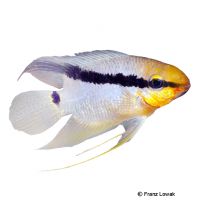Flag Cichlid (Mesonauta insignis)
| Flag Cichlid Mesonauta insignis | |
|---|---|
| Name | Flag Cichlid |
| Name Lat. | Mesonauta insignis |
| Synonym | Heros insignis |
| Family | Cichlids |
| Family lat. | Cichlidae |
| Order | Cichlids |
| Order lat. | Cichliformes |
| Origin | South America |
| Habitat | Streams, rivers |
| Diet | Omnivore |
| pH | 6.0-7.5 |
| Behavior | Peaceful |
| Keeping | Pair |
| Care Level | Moderate |
| Reproduction | Substrate spawner |
| Breeding | Moderately difficult |
| Life Span | N/A |
| Protection | No |
| Metric Units | |
| Size | 10-12 cm |
| Temperature | 24-28 °C |
| Hardness | 0-5 °dH |
| Aquarium | 150 l |
| US Units | |
| Size | 3.9"-4.7" |
| Temperature | 75-82 °F |
| Hardness | 0-89 ppm |
| Aquarium | 40 gal |
Distribution and habitat
The distribution area of the Yellow Flag Cichlids is the catchment area of the Rio Orinoco and the Rio Negro in Brazil and Venezuela. They live mainly in moderately flowing waters with dense riparian vegetation, sandy soft bottoms, dead wood and dense aquatic vegetation
Maintenance
The aquarium should have a dense border planting, with many hiding places (stones, roots, caves), and offer free swimming space. A dark sand substrate covered with some foliage (e.g. sea almond leaves), a weak current and shaded light (floating plants) is ideal.
No ammonia, ammonium and nitrite should be detectable, the nitrate value should not exceed 100 mg/l. To ensure the water quality and oxygen content, a filter and heater adapted to the aquarium size is required, as well as lighting for the species-appropriate day-night rhythm of the animals.
Diet
The food supply consists of live and frozen food, such as daphnia, artemia, mysis, shrimp and red mosquito larvae or a commercially available, frozen special food mix for cichlids. High-quality flake and granulated food for cichlids is also well accepted after acclimation. In addition, they need regular vegetable food, such as spinach, crushed peas, algae leaves or dry food with high vegetable content (spirulina).
Only feed as much as is eaten immediately (in a maximum of 10 minutes). Regular and varied feeding promotes health and increases resistance.
Behaviour and compatibility
They are calm, peaceful fish that should be kept in pairs. During the spawning season they behave territorial and defend their territory. Group keeping is only recommended in larger, richly structured tanks. They can be socialized well with other peaceful cichlids as well as tetras, barbs and catfishes.
Basically, only compatible fish species with similar demands on water condition and water temperature may be socialized.
Sex dimorphism
The sexes are difficult to distinguish. The larger males have slightly longer extended dorsal and anal fins. With some experience, the sexes can be distinguished by their genital papilla, which is pointed in the male and round in the female.
Reproduction and breeding
They spawn 200-500 eggs on flat stones or roots (open brooders). Both parents perform brood care and defend the territory (parental family). After about 2 days the fry hatch and are then usually housed in a bottom pit until they swim freely after 5-7 days. Often the fry are still guarded by the parents for some time and are led to the feeding places in the aquarium.
Fry must be fed several times a day with special rearing food (Artemia nauplii). In community tanks breeding is hardly possible, because the young fish are easy prey.
Important
Mesonauta insignis (Yellow Flag Cichlid) is often confused with Mesonauta festivus (Flag Cichlid), which lacks the yellow coloration on the throat and chest
These perches do not damage plants. They are very shy and skittish
The well-being of the fish should be checked regularly. Temperature should be checked daily, pH, hardness and nitrate levels at least every 14 days. Regular partial water changes are recommended, even if the contaminant level has not yet reached the upper limit. Sudden changes in water quality should be avoided. Newly introduced fish must be accustomed slowly to the water in the aquarium.
Further literature can be found in your pet store.
References
Text: Werner Winter; Image: Franz Lowak
Source: BMELV (1998): Tierschutzgutachten - Haltung von Zierfischen (Süßwasser); BAENSCH & RIEHL (1997): Aquarien Atlas Bd. 5, Mergus Verlag; ENGELMANN (2005): Zootierhaltung - Tiere in menschlicher Obhut: Fische, Verlag Harri Deutsch
- Gemäß § 21 Abs. 5 Tierschutzgesetz idgF
